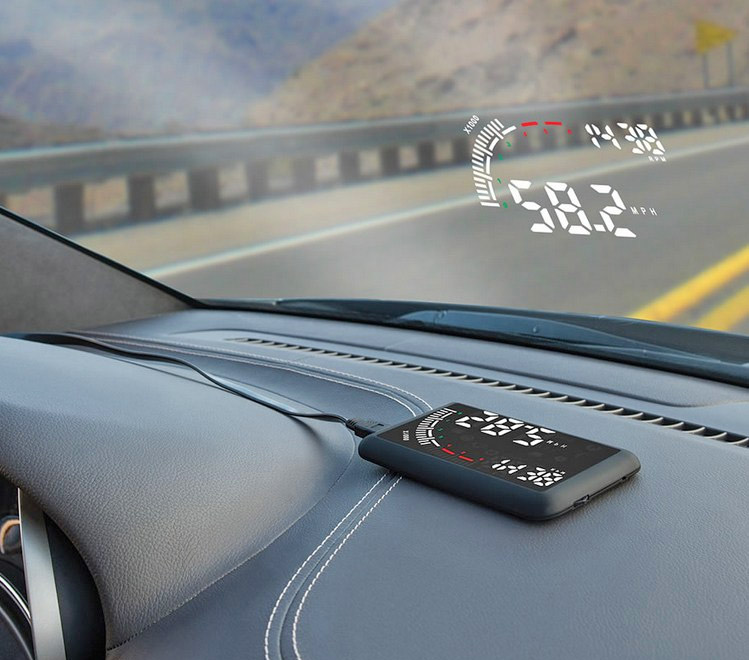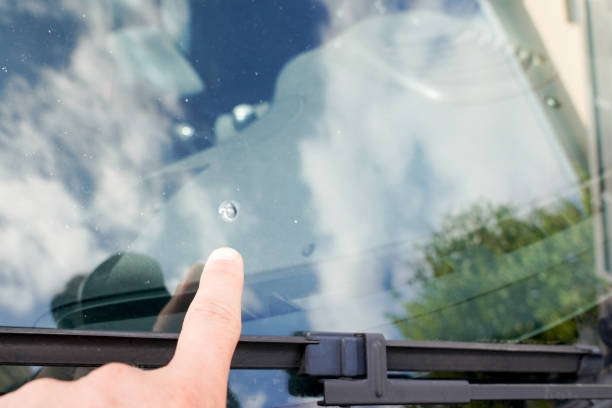Car Windshield Heads-Up Display (HUD): A Futuristic Driving Experience
Introduction
In the ever-evolving landscape of automotive technology, one innovation stands out for its potential to revolutionize the way we drive – the Car Windshield Heads-Up Display (HUD). Once confined to high-end luxury vehicles, HUD systems are now making their way into mainstream automobiles, promising safer, more convenient, and futuristic driving experiences. In this comprehensive guide, we will explore everything you need to know about Car Windshield HUDs, including how they work, their benefits, and why they're becoming increasingly popular among car enthusiasts. Buckle up as we embark on a journey into the future of automotive technology.

Chapter 1: What is a Car Windshield Heads-Up Display (HUD)?
Let's begin by understanding the basics:
1.1 HUD Definition
A Car Windshield Heads-Up Display, commonly referred to as a HUD, is an advanced technology system that projects critical driving information directly onto the vehicle's windshield. This information typically includes essential data like speed, navigation directions, and safety alerts.
1.2 How Does It Work?
-
Optical Projection: HUDs use optical projection technology to display information. A projector located within the dashboard or instrument cluster reflects the data onto a specialized transparent screen or the windshield itself.
-
Visibility: The information appears to float on the windshield, allowing drivers to access it without shifting their focus away from the road.
Chapter 2: Benefits of Car Windshield HUDs
Car Windshield HUDs offer a plethora of advantages that enhance both safety and convenience:
2.1 Enhanced Safety
-
Reduced Distraction: With crucial information displayed on the windshield, drivers can access it without taking their eyes off the road, minimizing distractions.
-
Improved Focus: HUDs promote better concentration by ensuring drivers maintain their line of sight, even while accessing vital data.
2.2 Real-Time Information
-
Speed and Navigation: HUDs provide real-time speed and navigation information, ensuring drivers are well-informed and can make quick decisions.
-
Safety Alerts: Hazard warnings, like lane departure and collision alerts, are prominently displayed, allowing for immediate response.
2.3 Convenience and Comfort
-
Customization: Drivers can often customize the HUD to display information most relevant to them, creating a personalized driving experience.
-
Night Vision: Some advanced HUDs incorporate night vision technology, further enhancing safety during low-light conditions.
Chapter 3: Types of Information Displayed on Car Windshield HUDs
Car Windshield HUDs can display a wide range of information:
3.1 Basic Information
-
Speed: The most common HUD display is vehicle speed, ensuring drivers can easily monitor their velocity without glancing at the dashboard.
-
Navigation: Turn-by-turn navigation instructions are projected, helping drivers follow routes without the need for a separate GPS screen.
3.2 Advanced Features
-
Collision Alerts: HUDs can warn drivers of potential collisions or lane departures, improving overall safety.
-
Traffic Information: Real-time traffic updates can help drivers navigate congested routes more efficiently.
3.3 Vehicle Status*
-
Fuel Efficiency: HUDs can display fuel efficiency data, allowing drivers to adjust their driving habits for better mileage.
-
Maintenance Alerts: HUDs may notify drivers of maintenance needs, such as low oil levels or tire pressure.
Chapter 4: Evolution of Car Windshield HUDs
Car Windshield HUD technology has come a long way since its inception:
4.1 Early Development*
-
Military Origins: HUD technology initially had military applications, such as fighter jet displays, before transitioning to automotive use.
-
Luxury Car Adoption: High-end automakers like BMW and Cadillac were among the first to incorporate HUDs into their vehicles.
4.2 Mainstream Integration*
-
Affordable Options: As technology advanced, HUD systems became more accessible to mainstream consumers, appearing in a broader range of vehicle models.
-
Third-Party HUDs: Some companies offer aftermarket HUD systems that can be added to older vehicles, further increasing their availability.
Chapter 5: Popular Car Models with Car Windshield HUDs
Car Windshield HUDs are no longer exclusive to luxury cars. Many popular car models across different price ranges now offer this technology:
5.1 Toyota Camry*
- Toyota Safety Sense: The Toyota Camry comes equipped with Toyota Safety Sense, which includes a Head-Up Display featuring key driving data.
5.2 Mazda CX-5*
- Active Driving Display: Mazda's Active Driving Display provides crucial information, ensuring drivers remain informed while focusing on the road.
5.3 Audi Q7*
- Virtual Cockpit: Audi's Virtual Cockpit integrates a high-resolution HUD that displays various customizable information.
5.4 Ford Mustang*
- Ford Mustang's HUD: Even the iconic Ford Mustang offers an available HUD system, enhancing its modern driving experience.
Chapter 6: Future Trends in Car Windshield HUDs
Chapter 6 explores the exciting future trends in Car Windshield HUD technology:
6.1 Augmented Reality (AR) HUDs
-
Enhanced Navigation: AR HUDs will offer even more immersive navigation experiences. Drivers will see information overlaid onto the real world, making it easier to follow directions and find points of interest.
-
Interactive Interfaces: Future HUDs may support gesture controls, allowing drivers to interact with the display without touching it. This hands-free approach can enhance safety and convenience.
6.2 Integration with Autonomous Driving
-
Autonomous Driving: As self-driving technology advances, HUDs will play a crucial role in providing information to passengers during their journeys. Passengers can access entertainment, work, or relax while keeping tabs on the vehicle's status through the HUD.
-
Enhanced Safety Alerts: HUDs will become integral in communicating with autonomous vehicles. They can display warnings and alerts to passengers when manual intervention is needed or when unexpected situations arise.
6.3 Enhanced Connectivity
-
5G Integration: The advent of 5G technology will enable faster data transmission to HUDs. This means more real-time information, such as traffic updates, weather forecasts, and streaming content, can be seamlessly displayed.
-
Smartphone Integration: HUDs may become more tightly integrated with smartphones, allowing drivers to access apps and services directly through the display. This can include making calls, sending messages, and controlling music playback.
Chapter 7: How to Use a Car Windshield HUD
Chapter 7 offers a detailed guide on effectively using a Car Windshield HUD:
7.1 Adjusting Display Settings
-
Positioning: HUDs often allow drivers to adjust the position and height of the display to their preference. It's essential to find a position that offers the best visibility without obstructing the road.
-
Brightness and Clarity: Ensure that the display is neither too dim nor too bright for optimal visibility. Adjust the brightness and clarity settings according to the ambient light conditions.
7.2 Customization
-
Data Selection: Familiarize yourself with the customization options offered by your HUD system. You can typically choose the information most relevant to your driving needs, such as speed, navigation, or safety alerts.
-
Color Schemes: Some HUDs offer color customization. Select a color scheme that is easy on the eyes and contrasts well with the displayed information.
7.3 Maintenance
-
Cleaning: Regularly clean the HUD's projector lens and the windshield in front of it. Dust, smudges, or debris can interfere with the projection and reduce visibility.
-
Software Updates: Keep your HUD's software up to date. Manufacturers often release updates to improve performance, add features, and fix bugs.
Chapter 8: Conclusion - The Future of Driving at Your Fingertips
In Chapter 8, we summarize the significant points covered in the guide:
8.1 Transformation of Driving
-
Safety and Convenience: Car Windshield HUDs are transforming the way we drive by enhancing safety and convenience.
-
Real-Time Information: These HUDs provide real-time data that helps drivers make informed decisions without taking their eyes off the road.
8.2 Evolution of HUD Technology
-
Accessibility: HUD technology is becoming more accessible, with a broader range of vehicle models offering these features.
-
Future Potential: As automakers continue to invest in HUD technology, we can expect even more advanced features, increased affordability, and widespread adoption.
8.3 A Glimpse into the Future
-
AR HUDs: The future promises more immersive AR HUDs that overlay information onto the real world, creating a seamless driving experience.
-
Integration with Autonomous Driving: HUDs will play a vital role in communicating with autonomous vehicles, ensuring passenger safety and providing entertainment during journeys.
-
Enhanced Connectivity: With the integration of 5G technology and smartphone connectivity, HUDs will offer a wealth of real-time information and seamless interaction.
Chapter 9: Exploring the HUD-Driven Future
In Chapter 9, we look ahead to the possibilities that HUD-driven technology may bring:
9.1 Improved Road Safety
-
Reduced Distraction: HUDs will continue to reduce distraction by displaying critical information directly in the driver's line of sight.
-
Advanced Driver Assistance: HUDs will play a crucial role in advanced driver assistance systems (ADAS), further enhancing vehicle safety.
9.2 Enriched Driving Experiences
-
Entertainment Integration: HUDs will provide more entertainment options, making long drives more enjoyable.
-
Personalization: Drivers will have even greater control over how they customize and use their HUDs.
9.3 Increased Efficiency and Productivity
-
Connected Services: HUDs will offer a wide range of connected services, from finding parking spaces to ordering food, making every drive more efficient and productive.
-
Work and Play: As autonomous driving becomes more prevalent, HUDs will enable drivers and passengers to work or engage in leisure activities during their commutes.
In conclusion, Car Windshield HUDs represent an exciting future for driving, where safety, convenience, and connectivity are seamlessly integrated into our daily journeys. As technology continues to advance, the driving experience will only become more enriched and efficient, promising a brighter, safer, and more enjoyable future on the road.



